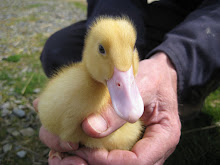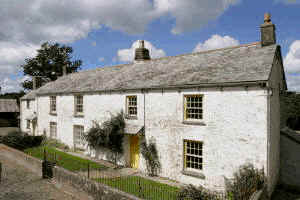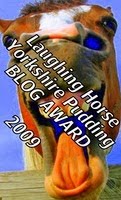Some months ago a friend 's purchase of some fancy young poultry had proved unlucky - most of the birds turned out to be cockerels and fought each other and then attacked the hands that fed them so sealing their fate. Knowing that we would be putting them in the pot, the glossy picturesque trio were handed over. One was made into fabulous Jewish penicillin - chicken soup - with strips of the boiling fowl, slices of the stuffed neck (using a dumpling suet mixture) and baby carrots cooked in the soup served as the main course. The second paid homage to the first, being prepared the same way and the third was eaten last night. Stuffed with chestnut, chive and celery stuffing, put in an open cast iron casserole with half a pint of giblet stock and a glass of white wine, covered with strips of our own streaky bacon it pot roasted its way to deliciousness. We served it to friends on Easter Sunday with parsnip and carrot mash, red cabbage, and rosemary roast potatoes. Mmmm mmm mmm. The carrot, parsnip, cockerel thing being so fab, I used the carcase to make chicken stock and threw in more of the same root veggies (I had dug up all our remaining parsnips that afternoon and instead of finding the half dozen or so I expected, two dozen big uns emerged and needed using), some cumin, coriander and celery salt. That'll provide us with soup for at least three days.
Now the vegetable garden has been cleared, mucked and rotovated, we have planted potatoes - organic Charlottes for earlies and Valour for main - carrots, chard and parsnips, and the stuff in the greenhouse is desperate to go out as soon as frost dangers seem to have passed. This is the first time I have lifted old parsnips and planted new over the same weekend, but in the spirit of rotation, they have a new position in the plot, where the muck is lightest. As always, I've had to put electric rabbit fencing round the plot to stop both rabbits and our own geese and ducks from chomping on the emerging shoots. As soon as the broad beans and brassicas go in they will need netting too to save them from pigeon deforestation. I swear that the birds sit on the telegraph lines just waiting for me to plant out the tender young things, so the netting has to be done immediately the plants are put in the ground.
Monday, 12 April 2004
Friday, 9 April 2004
It's lambing time - 2004
 The most demanding time on the smallholding is greeted with excitement and trepidation in equal measure. We put the ram in with the ewes at the beginning of November so that we lamb nice and late in the Spring at the beginning of April, so avoiding freezing February nights in the lambing shed. The ewes get wider and wider during March til some of them look like dining tables on spindly legs. You know the moment you have been waiting for is imminent when their nipples are the size of organ stops and lying down uncomfortably is their only activity between eagerly consumed feeds. Once you have your first few lambs, you spend your time peering nervously at the remaining expectant mothers, knowing that they are going to get started the moment you are needed elsewhere, and will probably need your unavailable help. This year we have had an unusual amount of singles and that makes for bigger lambs which in turn means the ewe is more likely to need a human latex-covered hand. The best moments are at 5.30 in the morning doing the first round of the day, and a pair of beautifully presented lambs are suckling eagerly at their attentive mother having needed no help from you at all. A quick dose of iodine on their navels to prevent infection, a bucket of congratulatory feed and one of water for the ewe (they drain that first post-birth bucket like a fugitive from the desert) and they are back outside. Each year we wonder at their behaviour, but why is it that the mums-to-be all cluster together and that the new mums set up creche in a separate cluster, welcoming each new mum as the ewes moves inexorably from one status to the other? After about a week, the lambs start to play together and leave the ewes for longer periods to congregate like kids in the school yard, playing chase at ever increasing speeds along the fenceline, proving that lambs do indeed have legs made of springs, by displays of vertical take-off. All this is very cliched and will be familiar to anyone with sheep, but each year it is a fresh miracle, and the sight of lambs continues to stop cars along the lane and gives folks time to grin on the way to and from work.
The most demanding time on the smallholding is greeted with excitement and trepidation in equal measure. We put the ram in with the ewes at the beginning of November so that we lamb nice and late in the Spring at the beginning of April, so avoiding freezing February nights in the lambing shed. The ewes get wider and wider during March til some of them look like dining tables on spindly legs. You know the moment you have been waiting for is imminent when their nipples are the size of organ stops and lying down uncomfortably is their only activity between eagerly consumed feeds. Once you have your first few lambs, you spend your time peering nervously at the remaining expectant mothers, knowing that they are going to get started the moment you are needed elsewhere, and will probably need your unavailable help. This year we have had an unusual amount of singles and that makes for bigger lambs which in turn means the ewe is more likely to need a human latex-covered hand. The best moments are at 5.30 in the morning doing the first round of the day, and a pair of beautifully presented lambs are suckling eagerly at their attentive mother having needed no help from you at all. A quick dose of iodine on their navels to prevent infection, a bucket of congratulatory feed and one of water for the ewe (they drain that first post-birth bucket like a fugitive from the desert) and they are back outside. Each year we wonder at their behaviour, but why is it that the mums-to-be all cluster together and that the new mums set up creche in a separate cluster, welcoming each new mum as the ewes moves inexorably from one status to the other? After about a week, the lambs start to play together and leave the ewes for longer periods to congregate like kids in the school yard, playing chase at ever increasing speeds along the fenceline, proving that lambs do indeed have legs made of springs, by displays of vertical take-off. All this is very cliched and will be familiar to anyone with sheep, but each year it is a fresh miracle, and the sight of lambs continues to stop cars along the lane and gives folks time to grin on the way to and from work.
Subscribe to:
Comments (Atom)
















